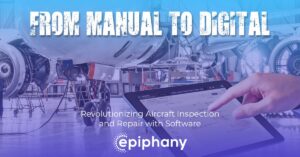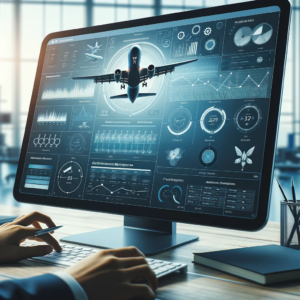In the highly regulated and safety-critical world of aviation, the consistent airworthiness of aircraft is of utmost importance. Maintenance, Repair, and Overhaul (MRO) operations form the backbone of this assurance, playing a crucial role in the operational safety, efficiency, and longevity of aircraft. The rapid technological advancements in the field, particularly through sophisticated MRO software, have dramatically transformed aviation maintenance practices. This article explores the profound impact of advanced MRO software on aviation maintenance, detailing how it enhances operational efficiency, ensures compliance with stringent regulations, and ultimately contributes to the overarching goal of flight safety.
Enhancing Operational Efficiency with Advanced MRO Software
Real-Time Data Analytics and Predictive Maintenance
The integration of real-time data analytics within MRO software has revolutionized the approach to aircraft maintenance. By utilizing advanced algorithms, these systems analyze data from various aircraft sensors and maintenance logs to provide timely insights into component health. This predictive maintenance model is pivotal in identifying potential issues before they manifest into critical problems, allowing for preemptive repairs that minimize downtime and extend the service life of aircraft components. The ability to predict and address maintenance needs proactively is a significant advancement over traditional reactive maintenance models, which often resulted in costly delays and unplanned groundings.
Streamlined Workflow Management
MRO software solutions are designed to streamline the complex workflows inherent in aviation maintenance. These tools provide an integrated platform for managing every aspect of maintenance operations—from scheduling and resource allocation to execution and documentation. By ensuring that all maintenance tasks are meticulously coordinated and recorded, MRO software reduces the likelihood of human error and enhances the overall efficiency of the maintenance process. The result is a more organized, reliable, and efficient maintenance operation that ensures aircraft are always maintained to the highest standards of safety and readiness.
Compliance with Aviation Regulations: A Non-Negotiable Priority
Automated Compliance Management
Aviation is one of the most heavily regulated industries in the world, with stringent compliance requirements that must be adhered to at all times. Advanced MRO software plays a critical role in this regard by automatically updating and integrating the latest regulatory standards and guidelines into maintenance protocols. This feature ensures that all maintenance activities are conducted in strict accordance with current regulations, significantly reducing the risk of non-compliance. The automation of compliance management not only enhances safety but also provides peace of mind to operators, knowing that their maintenance practices are always aligned with the latest regulatory requirements.
Real-Time Collaboration and Accessibility
The global nature of the aviation industry necessitates a high level of collaboration among maintenance teams, often spread across different geographical locations. Cloud-based MRO software platforms facilitate real-time collaboration, allowing maintenance teams to work together seamlessly, regardless of their physical location. This real-time accessibility ensures that expertise and resources can be effectively shared across borders, enhancing the quality and efficiency of maintenance operations. The ability to collaborate in real-time is particularly beneficial in addressing complex maintenance challenges that require input from multiple experts or specialists.
The Synergy Between Technology and Human Expertise
Augmenting Human Capabilities
While advanced MRO software offers numerous advantages, it is essential to recognize that these tools are designed to augment, not replace, the expertise of human technicians. The role of skilled maintenance personnel remains irreplaceable, particularly in the execution of complex maintenance tasks that require a high level of technical proficiency and judgment. MRO software enhances human capabilities by automating routine tasks, providing actionable insights, and supporting decision-making processes. This synergy between technology and human expertise is what ultimately drives improvements in maintenance practices, ensuring that aircraft are maintained to the highest possible standards.
Case Studies: Real-World Success of MRO Software Integration
Airline Efficiency Gains
Several airlines and MRO organizations have reported significant operational improvements following the integration of advanced MRO software. For instance, one leading airline achieved a 20% reduction in unscheduled maintenance events, attributing this success to the predictive capabilities of their MRO software. By identifying and addressing potential maintenance issues before they escalated, the airline was able to reduce aircraft downtime, improve operational efficiency, and enhance overall safety.
Compliance and Operational Excellence
Another notable example is an aviation maintenance organization that achieved near-perfect compliance with regulatory standards after implementing a comprehensive MRO software solution. The software’s automated compliance management features ensured that all maintenance activities were conducted in accordance with the latest regulations, resulting in a flawless compliance record. This success not only enhanced the organization’s reputation but also contributed to safer and more efficient maintenance operations.
The Future of Aviation Maintenance: Embracing Emerging Technologies
Artificial Intelligence and Machine Learning
The future of aviation maintenance is inextricably linked to the ongoing evolution of MRO software, particularly in the areas of artificial intelligence (AI) and machine learning (ML). These technologies are poised to bring about even greater advancements in maintenance practices, with the potential for fully automated diagnostics, predictive maintenance, and optimized scheduling. AI-driven MRO software will enable more accurate predictions of maintenance needs, further reducing the likelihood of unscheduled maintenance events and enhancing the overall reliability of aircraft.
The Rise of Autonomous Maintenance Systems
Looking ahead, the integration of autonomous maintenance systems into MRO software represents a significant leap forward. These systems will utilize AI and ML to conduct automated inspections, diagnostics, and even repairs, with minimal human intervention. The adoption of such technologies will not only improve maintenance efficiency but also reduce the risk of human error, further elevating the standards of aviation safety.
The role of advanced MRO software in aviation maintenance is undeniably transformative. By enhancing operational efficiency, ensuring regulatory compliance, and augmenting human expertise, these tools play a critical role in maintaining the safety, reliability, and longevity of aircraft. As the aviation industry continues to evolve, the integration of emerging technologies such as AI and ML into MRO software will further elevate maintenance practices, setting new benchmarks for safety and efficiency. For aviation operators, the adoption of advanced MRO software is not just a strategic advantage—it is a necessity in the pursuit of operational excellence and flight safety.






